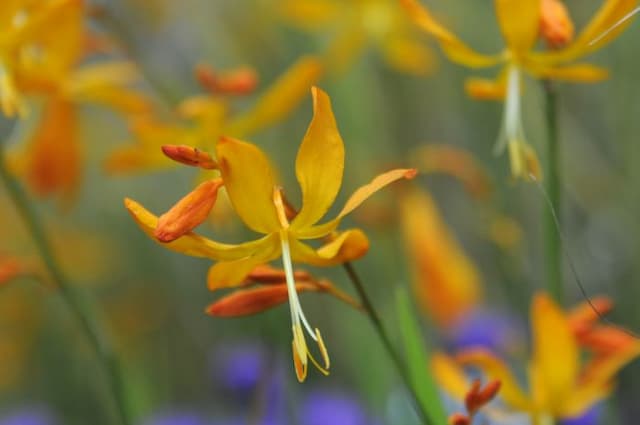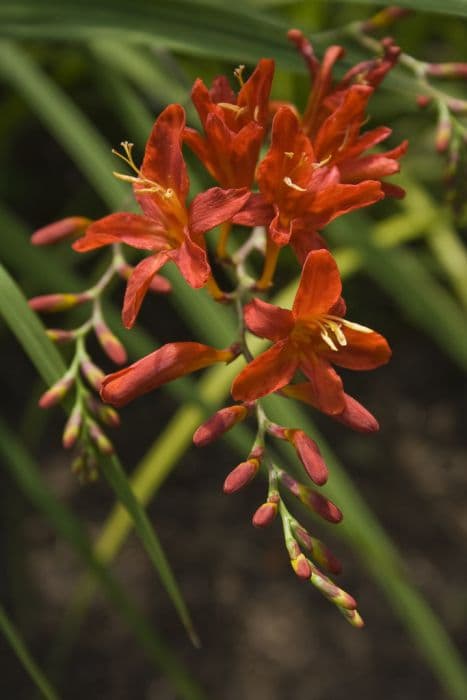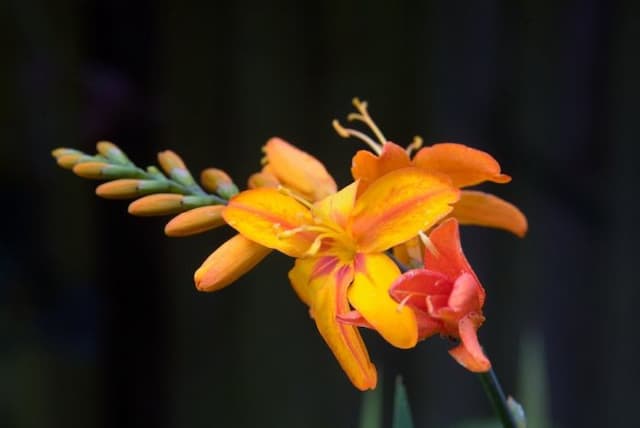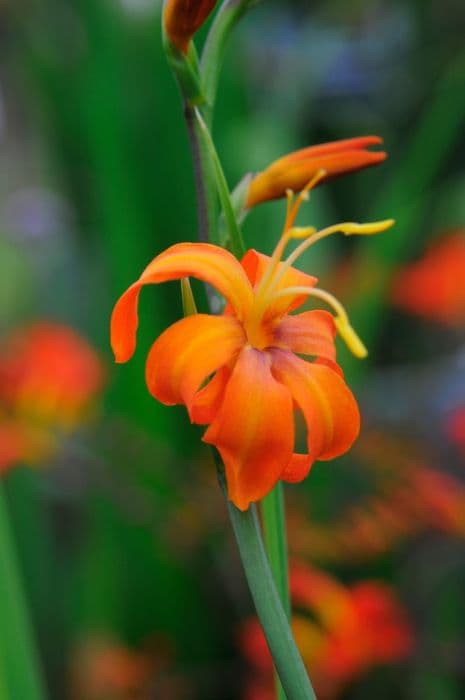Crocus 'Snow Bunting' Crocus 'Snow Bunting'

ABOUT
'Snow Bunting' is a perennial corm with fragrant white flowers which are greenish-yellow in the throat, with orange stigmas
About this plant
 Names
NamesFamily
Iridaceae.
Synonyms
Snow Bunting Crocus.
Common names
Crocus 'Snow Bunting'
 Characteristics
CharacteristicsLife cycle
Perennials
Foliage type
Deciduous
Color of leaves
Green
Flower color
White
Height
3-6 inches (7.5-15 cm)
Spread
2-4 inches (5-10 cm)
Plant type
Bulb
Hardiness zones
3-8
Native area
Mediterranean
Benefits
 General Benefits
General Benefits- Early Spring Bloom: Crocus 'Snow Bunting' flowers early in the spring, providing one of the first bursts of color in the garden after winter.
- Attracts Pollinators: The blooms of the Crocus 'Snow Bunting' attract bees and other early-spring pollinators, supporting the ecosystem.
- Low Maintenance: This plant is known for being low maintenance, requiring minimal care once established in appropriate conditions.
- Cold Tolerance: Crocus 'Snow Bunting' is hardy and can tolerate cold winter temperatures, making it suitable for cooler climate gardens.
- Naturalizing: This crocus has the ability to naturalize, meaning it can spread and proliferate over time, creating larger displays each year.
- Small Size: Due to its small size, Crocus 'Snow Bunting' is perfect for planting in rock gardens, borders, or as a lawn specimen for a spring display.
- Landscape Versatility: Its compact growth habit and early flowering make it versatile for a variety of landscaping applications, including containers and window boxes.
 Medical Properties
Medical PropertiesThis plant is not used for medical purposes.
 Air-purifying Qualities
Air-purifying QualitiesThis plant is not specifically known for air purifying qualities.
 Other Uses
Other Uses- Crocus 'Snow Bunting' can be used in crafting and flower arranging, as the flowers add a delicate touch to homemade wreaths and floral decorations.
- The stigmas from the crocus flowers can be collected and used as a natural dye for textiles, imparting a soft yellow or golden hue.
- In photography, the vivid colors of the Crocus 'Snow Bunting' make it an attractive subject for macro and close-up photography enthusiasts.
- Crocus 'Snow Bunting' can be a teaching aid in botanical studies, illustrating plant life cycles and bulb growth in educational settings.
- The plant can serve as a natural indicator of the coming of spring, with its early blooming being a phenological event watched by nature enthusiasts.
- Garden designers use Crocus 'Snow Bunting' for creating 'rivers' of color in large landscape designs by planting them in sweeping drifts.
- They can be planted in lawns to create a naturalized look and provide early spring interest before the grass needs mowing.
- Crafters might use the dried petals of the crocus in potpourri mixes for a subtle hint of color and a botanical component.
- For culinary presentations, the petals of Crocus 'Snow Bunting' can be used as an edible decoration on salads and desserts.
- Those practicing color therapy might use the uplifting colors of the crocus to create a calming space in their home or office during early spring.
Interesting Facts
 Feng Shui
Feng ShuiThe Crocus is not used in Feng Shui practice.
 Zodiac Sign Compitability
Zodiac Sign CompitabilityThe Crocus is not used in astrology practice.
 Plant Symbolism
Plant Symbolism- Hope: The Crocus 'Snow Bunting' is often seen as a symbol of hope because it is one of the first flowers to bloom at the end of winter, signifying the imminent arrival of spring.
- Youthfulness: Its delicate and youthful appearance is symbolic of youth and joy, representing the freshness of life.
- Cheerfulness: The bright color of the Crocus 'Snow Bunting' is reminiscent of cheerfulness, lifting the spirits and symbolizing happiness.
- Renewal: The flower’s emergence from the cold ground is indicative of renewal and the cycle of life, rebirth, and new beginnings.
- Purity: The pure white color of the Crocus 'Snow Bunting' is often associated with purity and truth.
 Water
WaterSnow Crocus require moderate watering during their growth and blooming season, typically in the early spring. It's essential to keep the soil consistently moist but not waterlogged. To achieve this, water the plant with about 1 inch of water once a week, depending on the weather conditions. During the dry spells, you may need to water them twice a week. However, once they have finished flowering and start to go dormant, reduce watering significantly to prevent bulb rot.
 Light
LightSnow Crocus thrive best in full sun to partial shade. They should be planted in a spot where they receive at least 6 hours of direct sunlight each day. Too much shade can result in weak or spindly growth, so the ideal location is one that gets plenty of morning sunlight but is shielded from the intense heat of the late afternoon sun.
 Temperature
TemperatureSnow Crocus are hardy and can withstand winter temperatures down to about -20 degrees Fahrenheit, making them well-suited for cooler climates. They prefer the cooler spring temperatures to bloom and perform best when the daytime temperatures are between 60 and 70 degrees Fahrenheit. Extreme heat can be detrimental, so they should be shielded from the hot temperatures above 80 degrees Fahrenheit.
 Pruning
PruningPruning is not typically required for Snow Crocus, as the leaves should be allowed to die back naturally after blooming to replenish the bulbs for the next season. Deadheading the faded flowers can tidy up the plant's appearance, but it's not necessary for the plant's health. The best time to remove dead foliage is when it has turned yellow and can be easily pulled off without resistance.
 Cleaning
CleaningNot needed
 Soil
SoilCrocus 'Snow Bunting', commonly known as Snow Crocus, thrives best in well-draining soil with a neutral to slightly alkaline pH of around 6.0 to 7.5. An ideal soil mix for this plant would consist of equal parts loam, sand, and compost or well-rotted manure to provide both drainage and fertility. Adding a small amount of gravel or grit to the mix can further enhance drainage, crucial for preventing bulb rot.
 Repotting
RepottingSnow Crocuses do not typically require frequent repotting and can be left undisturbed for several years. They should be repotted or divided only when the clumps become overcrowded, roughly every 4 to 5 years. It's best to handle repotting after the foliage has died back post-flowering, indicating the plant's dormancy.
 Humidity & Misting
Humidity & MistingSnow Crocuses are relatively adaptable and do not require special humidity conditions. They are tolerant of the typical humidity levels found in most outdoor settings. Ensuring proper soil drainage and avoiding excessive moisture around the base of the plants will keep them thriving more than managing specific humidity levels.
 Suitable locations
Suitable locationsIndoor
Place in a well-lit spot, water sparingly.
Outdoor
Plant in full sun, well-draining soil, cool spot.
Hardiness zone
3-8 USDA
 Life cycle
Life cycleThe Crocus 'Snow Bunting', commonly known as Snow Bunting Crocus, begins its life cycle as a corm, surviving underground during winter dormancy. In early spring, as temperatures rise, it breaks dormancy and shoots emerge, rapidly growing into slender, grass-like leaves and flowering stems. The plant produces its characteristic white flowers, which are an early source of nectar for pollinators. After flowering, which can last for several weeks, the plant enters the post-bloom phase where it focuses on photosynthesis and storing energy in the corm for the next season. During summer, the foliage dies back, and the corm enters a period of dormancy throughout the hot months and into the fall. This cycle repeats annually, with the corm producing offsets over time, enabling the plant to propagate and form clumps of new plants.
 Propogation
PropogationPropogation time
Late summer-early fall
The Crocus 'Snow Bunting', commonly known as the Snow Bunting crocus, is typically propagated through division of corms. The best time to propagate these plants is in the late summer or early fall, after the foliage has died back and the corms have had a chance to rest. To propagate, gently dig up the corms and carefully separate any corms that have formed clusters. These individual corms can then be replanted immediately, placing them about 3 to 4 inches (7.5 to 10 cm) deep and spaced about 3 inches (7.5 cm) apart, in well-draining soil with good sunlight exposure. This method encourages the development of strong, new plants that will bloom the following spring.


![Montbretia [Bright Eyes]](/_next/image?url=https%3A%2F%2Fplants-admin.emdemapps.com%2Fimages%2Fplants%2F%2Fimages%2F604b5f4a483b6.png&w=640&q=75)






